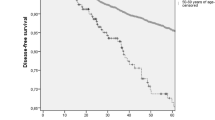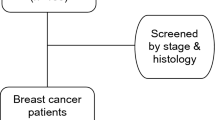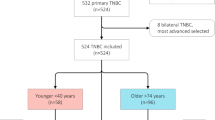Abstract
The aim of this investigation was to compare clinical pathological characteristics and prognosis of very young and older triple-negative breast cancer (TNBC) patients in order to assess their relevance to TNBC in an younger population. Data of TNBC patients diagnosed between 2002 and 2007 were retrospectively analyzed by computer based chart information. Baseline tumor characteristics, biological markers, and patients’ prognosis were compared between very young (≤35 years) and older (>35 years) TNBC patients. In the 216 cases of operable TNBC patients, 48 (22.2 %) were ≤35 years and 168 (77.8 %) were >35 years. Very young TNBC patients had showed a high clinical stage, more positive lymph nodes, Ck5/6 and/or EGFR expression (P = 0.049, 0.006, and 0.011, respectively). Compared to older TNBC patients, very young TNBC patients have short disease-free survival (P = 0.031), while no significant difference was found in overall survival (OS) (P = 0.075). In multivariate analysis, lymph node metastatic status was a significant predictor of OS. TNBC of very young patients is an aggressive breast cancer subtype, but the overall survival of both young and older TNBC patients did not have significant differences.


Similar content being viewed by others
References
Gennari R, Curigliano G, Rotmensz N, et al. Breast carcinoma in elderly women: features of disease presentation, choice of local and systemic treatments compared with younger post-menopasual patients. Cancer. 2004;101:1302–10.
Colleoni M, Rotmensz N, Robertson C, et al. Very young women (<35 years) with operable breast cancer: features of disease at presentation. Ann Oncol. 2002;13:273–9.
Muss HB, Woolf S, Berry D, et al. Adjuvant chemotherapy in older and younger women with lymph node-positive breast cancer. JAMA. 2005;293(9):1073–81.
Mise M, Higashide S, Hashimoto K, et al. Clinicopathological features of young patients with triple negative breast cancer. Gan To Kagaku Ryoho. 2009;36(10):1677–81.
Han W, Kim SW, Park IA, et al. Young age: an independent risk factor for disease-free survival in women with operable breast cancer. BMC Cancer. 2004;4:82.
Schonberg MA, Marcantonio ER, Li D, et al. Breast cancer among the oldest old: tumor characteristics, treatment choices, and survival. J Clin Oncol. 2010;28(12):2038–45.
Du X, Goodwin JS. Patterns of use of chemotherapy for breast cancer in older women: findings from Medicareclaims data. J Clin Oncol. 2001;19(5):1455–61.
Cancello G, Maisonneuve P, Rotmensz N, et al. Prognosis and adjuvant treatment effects in selected breast cancer subtypes of very young women (<35 years) with operable breast cancer. Ann Oncol. 2010;21:1974–81.
Ring A, Sestak I, Baum M, et al. Influence of comorbidities and age on risk of death without recurrence: a retrospective analysis of the arimidex, tamoxifen alone orin combination trial. J Clin Oncol. 2011;1029(32):4266–72.
Rapiti E, Fioretta G, Verkooijen HM, et al. Survival of young and older breast cancer patients in Geneva from 1990 to 2001. Eur J Cancer. 2005;41:1446–52.
Bauer KR, Brown M, Cress RD, et al. Descriptive analysis of estrogen receptor (ER)-negative, progesterone receptor (PR)-negative, and HER2-negative invasive breast cancer, the so-called triple-negative phenotype: a population-based study from the California cancer Registry. Cancer. 2007;109:1721–8.
Carey LA, Perou CM, Livasy CA, et al. Race, breast cancer subtypes, and survival in the Carolina Breast Cancer Study. JAMA. 2006;295:2492–502.
Foulkes WD, Smith IE, Reis-Filho JS. Triple negative breast cancer. N Engl J Med. 2010;363(20):1938–48.
Dent R, Trudeau M, Pritchard KI, et al. Triple-negative breast cancer: clinical features and patterns of recurrence. Clin Cancer Res. 2007;13(15 Pt 1):4429–34.
Yang MT, Rong TH, Huang ZF, et al. Clinical analysis of resectable breast cancer: a report of 6 263 cases. Ai Zheng. 2005;24:327–31.
Han W. Kang SY: relationship between age at diagnosis and outcome of premenopausal breast cancer: age less than 35 years is a reasonable cut-off for defining young age-onset breast cancer. Breast Cancer Res Treat. 2010;119:193–200.
Goldhirsch A, Ingle JN, Gelber RD, et al. Thresholds for therapies: highlights of the St Gallen International Expert Consensus on the primary therapy of early breast cancer 2009. Ann Oncol. 2009;20:1319–29.
Walker RA, Lees E, Webb MB, et al. Breast carcinomas occurring in young women (<35 years) are different. Br J Cancer. 1996;74:1796–800.
Chung M, Chang HR, Bland KI, et al. Younger women with breast carcinoma have a poorer prognosis than older women. Cancer. 1996;77:97–103.
Winchester DP, Osteen RT, Menck HR. The national cancer data base report on breast carcinoma characteristics and outcome in relation to age. Cancer. 1996;78:1838–43.
Iwase H, Kurebayashi J, Tsuda H, et al. Clinicopathological analyses of triple negative breast cancer using surveillance data from the Registration Committee of the Japanese Breast Cancer Society. Breast Cancer. 2010;17:118–24.
Rodríguez-Pinilla SM, Sarrió D, Honrado E, et al. Prognostic significance of basal-like phenotype and fascin expression in node negative invasive breast carcinomas. Clin Cancer Res. 2006;12(5):1533–9.
Nielsen TO, Hsu FD, Jensen K, et al. Immunohistochemical and clinical characterization of the basal-like subtype of invasive breast carcinoma. Clin Cancer Res. 2004;10:5367–74.
Konigsberg R, Pfeiler G, Klement T, et al. Tumor characteristics and recurrence patterns in triple negative breast cancer: a comparison between younger (<65) and elderly (P65) patients. Eur J Cancer. 2012.
Conflict of interest
All authors have no conflicts of interest.
Ethical standard
Informed consent had been obtained, and the Ethics Committee of Harbin Medical University approved this study.
Author information
Authors and Affiliations
Corresponding author
Rights and permissions
About this article
Cite this article
Liu, Y., Xin, T., Huang, Dy. et al. Prognosis in very young women with triple-negative breast cancer: retrospective study of 216 cases. Med Oncol 31, 222 (2014). https://doi.org/10.1007/s12032-014-0222-2
Received:
Accepted:
Published:
DOI: https://doi.org/10.1007/s12032-014-0222-2




